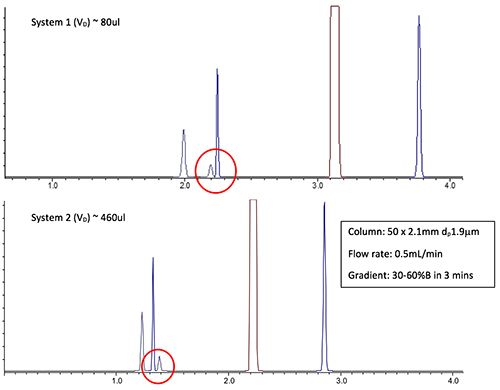The LCGC Blog: Dwell Volume – Still Relevant in our UHPLC World?
With the increasing proliferation of UHPLC, with its very much reduced extra column volumes, is the concept of dwell volume still relevant? Indeed, in your world, was it ever relevant at all?
With the increasing proliferation of UHPLC, with its very much reduced extra column volumes, is the concept of dwell volume still relevant? Indeed, in your world, was it ever relevant at all?
I’m sure most of us are aware that Dwell Volume (VD), is the volume in our HPLC system from the point at which eluent solvents are mixed to the head of the packed bed within the column. This will vary due to differences in instrument configurations from the same manufacturer and between manufacturers. Perhaps the largest differences are seen between quaternary and binary systems, where in the former, as the solvent are mixed using a proportioning valve situated before the pump head, the volume of the pump heads need to be considered. In binary pumping systems, the solvents are mixed after the pump (gradient composition being controlled by varying the speed or volume from each of the two pumps), in which case the dwell volume is typically much lower. For convenience, we often talk of dwell time (tD) which is simply the dwell volume divided by the flow rate.
Before considering the relevance of gradient dwell volumes in the modern laboratory, we should consider why dwell volume is a factor for consideration at all.
Analyte separation in gradient HPLC differs from that in the isocratic mode in that the retention factor (k*) is constantly changing, some analytes having very high values of k at the start of the gradient. That is, some analytes remain stationary at the head of the column until the eluotropic strength is sufficient in order from them to begin partitioning into the mobile phase. Other more polar analytes will have lower values of k even at low % organic and will begin to immediately move through the column. As such, the retention behavior at the beginning of the gradient is extremely susceptible to variations in eluent composition with time, and therefore any changes to the initial % of organic present and indeed to the time after injection at which the organic composition begins to change. Put very simply, different dwell times (volumes) can affect the selectivity of a separation in gradient HPLC.
The practical implication here is that, if the gradient takes a shorter or longer time to reach the column after the sample is injected due to inherent differences in system dwell volume, then the initial composition that the sample experiences may change; and further, if the time taken for eluent composition to begin changing is longer than in the original method, further changes to separation selectivity, and hence resolution, may occur.
I’ve shown two separations using older HPLC equipment in Figure 1, which clearly demonstrates a change is selectivity between peaks 2 and 3, and the only difference between the two separations is in the dwell volumes of the systems used. At the start of the separation the analytes experience an initial (artificial) isocratic period of 0.33 min for system 1 and 1.67 min for system 2, during which the analyte behavior will differ for each analyte (assuming their chemistry is sufficiently different).
Figure 1: Change in selectivity in the separation of an active pharmaceutical ingredient (API) and several process impurities in early stage development, on two separate conventional HPLC system with widely varying dwell volumes.

So, back to our original question of whether this phenomenon still relevant in very small extra column volume UHPLC systems. Do we still need to be concerned about the effects of dwell volumes when developing methods and transferring between different ultra-high-performance instruments?
The simple answer is yes, for no matter how small the volumes involved, the issues scale accordingly. In UHPLC instruments with reduced diameter columns and capillary tubing, there are still differences between systems (inter and intra manufacturer) and transferring between (for example), a binary and quaternary system will still need careful consideration given to the dwell volumes of each system.
Figure 2 clearly shows that these issues are still relevant. The separation from Figure 2 was transferred to a UHPLC system and the column dimensions and gradient profile scaled accordingly. The upper chromatogram was obtained on a binary system with a very low dwell volume of 80μL. When the separation was transferred to a quaternary system with 460 μL dwell volume, a complete inversion of retention occurs between peaks 2 and 3!
Figure 2: Change in selectivity noted when using UHPLC systems with varying dwell volume (sample details as per Figure 1 / only first 4 min of chromatogram shown)

So, what could be done to reproduce the chromatogram from the binary system on the quaternary model? At first this may seem an intractable problem as it’s impossible to reconfigure the quaternary system to have dwell volumes as low as the binary system. However, using a trick available on most UHPLC systems, we might pre-start the gradient prior to injection, so that the exact gradient conditions may be experienced by the analytes on both systems. The difference between dwell volumes on both systems is 380 μL (460 μL-80 μL), which at 0.5mL/min eluent flow, represents a dwell time difference of around 45 s (0.38 / 0.5 x 60). So, if we start the gradient “forming” 45 s before carrying out the injection, we would be able to exactly mimic the conditions of the first analysis. For those purists out there, we may also insert a short (10 s) isocratic hold 45 s into the gradient on the quaternary system to mimic the 80 μL dwell volume from the binary system (0.08/0.5 x 60) and then continue the gradient at the same steepness (for example, %B/min) from the end of the 10-s hold.
What could we do if the separation was developed on the quaternary system but wanted to transfer to a binary instrument? This is more straightforward and is a simple matter of inserting an isocratic hold into the binary system gradient equal to the difference in dwell times between each instrument, in this case 45 s, prior to programming the gradient (30 – 60%B in 5 min). So, the gradient table would be:

So why do we not see dwell volumes annotated onto the systems within our laboratory? Well in good laboratories you do! I guess this depends upon the number of different instrument types and configurations that exist within a business and how often methods get transferred between instruments or sites, however, I believe we all should know the dwell volumes of each instrument that we work on and be aware of the impact of changing dwell volumes that I have outline above.
While measuring the system, dwell volume is not absolutely trivial. Once you have done it once, it really is straightforward and only needs to re-measured if the system configuration is changed, typically if the mixer volume is changed or if significant volumes, such as in-line filters or tubing of different length or diameter are added between the pump and autosampler or the autosampler and the column.
A simple experiment is shown in Figure 3 for measuring dwell volume on UHPLC systems.
Figure 3: Measurement of VD on UHPLC systems (reproduced courtesy of Agilent Technologies, Santa Clara, CA)

Experimental details:
Column: 1m of 0.125 mm capillary tubing (red striped PEEK tubing)
Solvent A: HPLC grade water
Solvent B: HPLC grade water with 0.6% v/v acetone (3.0 mL in 500 mL)
Detection: UV at 254 nm
Gradient: 0–100% B in 5 min
Flow rate: 0.5 mL/min
In summary then, the requirement to know, and adjust for changes in dwell volume in both HPLC and UHPLC is very real, especially when developing methods for implementation in disparate sites on equipment which may vary in configuration or manufacturer. In this way, issues with transfer of gradient (U)HPLC methods will be very much more straightforward and a little time spent to properly understand the systems you work with can save many future issues!

Tony Taylor is the technical director of Crawford Scientific and ChromAcademy. He comes from a pharmaceutical background and has many years research and development experience in small molecule analysis and bioanalysis using LC, GC, and hyphenated MS techniques. Taylor is actively involved in method development within the analytical services laboratory at Crawford Scientific and continues to research in LC-MS and GC-MS methods for structural characterization. As the technical director of the CHROMacademy, Taylor has spent the past 12 years as a trainer and developing online education materials in analytical chemistry techniques.
The LCGC Blog: Historical (Analytical) Chemistry Landmarks
November 1st 2024The American Chemical Society’s National Historic Chemical Landmarks program highlights sites and people that are important to the field of chemistry. How are analytical chemistry and separation science recognized within this program?
